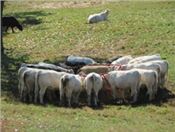Surviving The Next Four Months In Three Steps: Test Forage, Study Nutrient Needs, And Sort Cattle

When limiting hay be sure there is adequate space for all the animals to get around the feeder.
MT. VERNON, MO.
Beef cattle producers in southwest Missouri have about four months to manage their forage supply to accommodate their beef cattle's nutrient needs according to Eldon Cole, field specialist in livestock with University of Missouri Extension.
The forage supply may be stockpiled fescue, hay of questionable nutrient content, emergency silage or haylage.
THE FIRST STEP
“The first step is to collect samples and test the forage especially if it has never been fed before,” said Cole.
According to Cole, corn silage is an excellent feed as a rule, but for most cattlemen in this area, it is a new adventure.
The “book value” for corn silage is 30 percent dry matter; 65 to 70 percent total digestible nutrients (TDN) and 7 to 8 percent crude protein. TDN and protein are on a dry matter basis.
“Usually, plain fescue hay is the staple of the winter feed supply,” said Cole.
Fescue hay, properly harvested and stored makes decent hay with around 10 percent protein and 53 to 57 percent TDN. However, if mature and headed out when cut, those values can drop to 7 and into the '40s. If stored outside and possibly under trees, its feed value plummets.
“Twenty dollars spent on a forage test is a bargain as you calculate what supplements you need,” said Cole.
THE SECOND STEP
The second step is to study nutrient needs of the different classes of cattle that will be feed in the next 120 days.
“The primary nutrients are energy and protein. Dry, mature pregnant beef cows that will not be calving until February or March can get by on relatively poor hay if they’re a body condition score 5 or 6 or even higher,” said Cole.
The recommended ration for this class is 8 percent protein and 52 percent TDN.
These same cows, nursing young calves have a requirement of 10 percent protein and 58 percent TDN. Younger cows and heifers nursing calves may require a ration of 11 percent protein and 65 percent TDN.
“If BCS should fall into the 4 range in which multiple pairs of ribs are evident, along with the spine they need a ration that results in a gaining condition to move the animal up by 80 or 100 lbs. to attain a 5 BCS. This is unlikely to occur unless a major improvement is made in both the quality and quantity of the ration,” said Cole.
Bulls also need nutritional help if their BCS falls below a 5.
“In most cases, bulls benefit from complete removal from the cow herd for a while if you have better-conditioned bulls to replace them,” said Cole.
THE THIRD STEP
Sorting the cow herd into pastures based on their nutrient needs is advised as a third step.
“It is a challenge to do but running dry cows in the same pasture as cows nursing newborns along with some virgin replacement females just doesn’t work,” said Cole.
Cattle producers often feed more hay than the cows require. Cattle will eat until they are full then lay and mess on the remains.
“When forage supplies are short, limit intake by unrolling or only let the cattle have access to the hay or haylage for part of the day. When intake is being limited, make sure there is room for all animals at the table,” said Cole.
Supplementing forages with a concentrate feed may be the logical thing to do this winter. Cattle do need forage for proper rumination.
From an energy density standpoint, corn or some of the by-product feeds have twice the TDN levels per pound as hay that is in the 40's on TDN percentage. Cole recommends comparing the cost of protein and/or TDN pound-for-pound on feeds you are interested in.
“If you are shopping for hay consider alfalfa. It does not have to be dairy quality, supreme grade which could be out of your price range,” said Cole.
Alfalfa that tests 18 percent protein and 60 percent TDN can be limited in daily feed at 5 to 7 pounds. It might also be fed every other day at 10 or 12 pounds.
“There’s something about alfalfa that works with a wide range of grass hays. It’s also attractive to fall-born calves as a creep supplement,” said Cole.
In addition to protein and energy, low-quality forages may need a boost in vitamin A and minerals including salt.
“An economical way to cover vitamin A is by using an injectable product if you have the opportunity. Mineral supplements should be available at all times in a weather-protected feeder,” said Cole.
Another tip is to include an approved ionophore in concentrate supplements.
“Let’s hope for a mild next 120 days as all of the requirements given in this article won’t be sufficient if the winter is wet and below normal temperatures,” said Cole. ∆